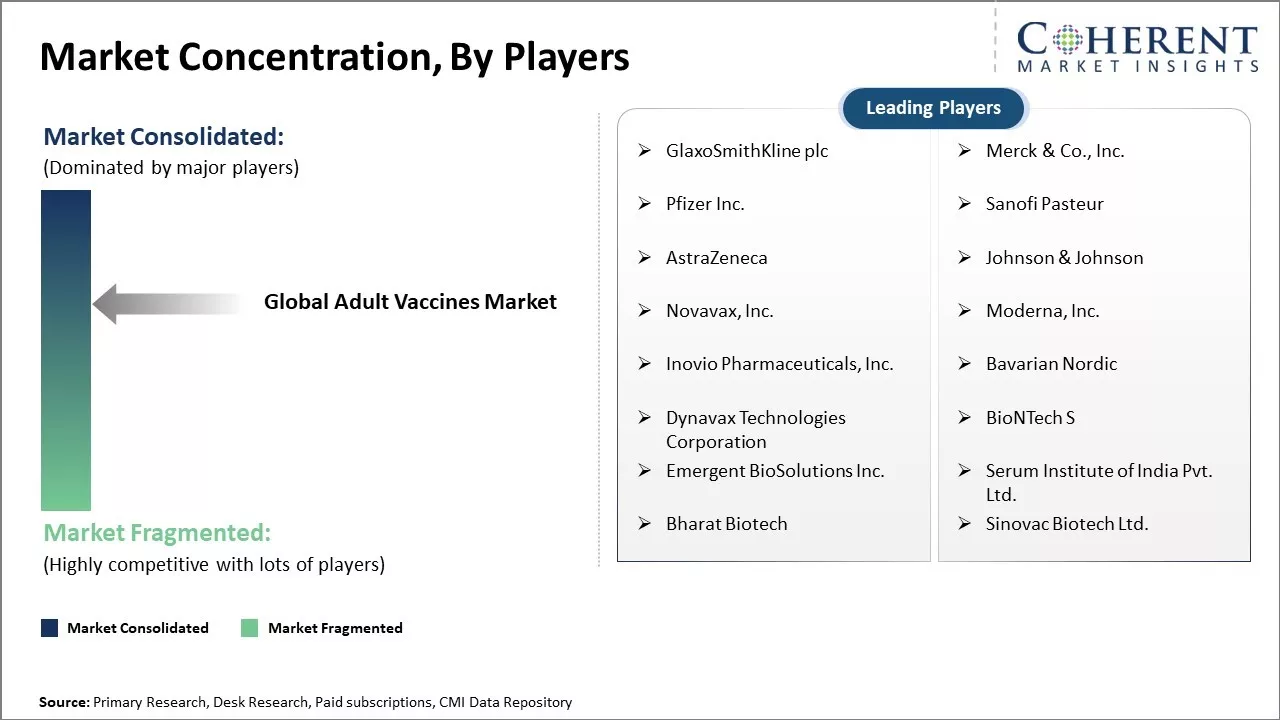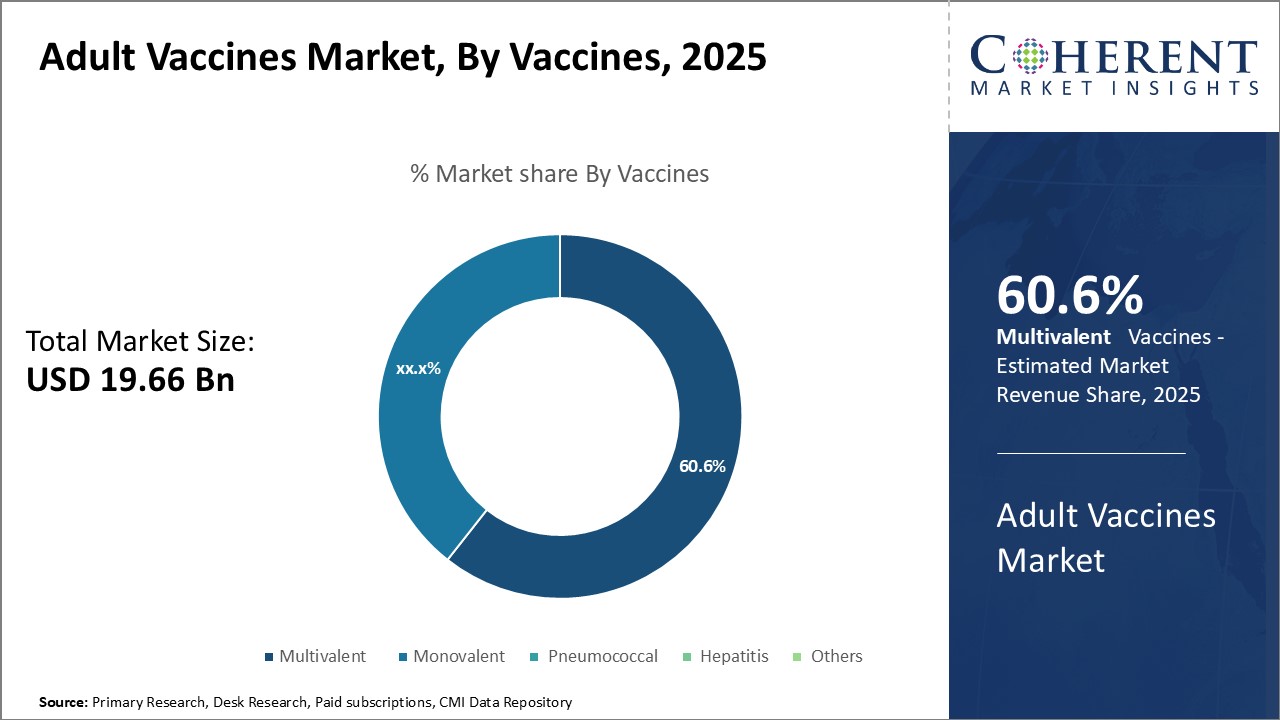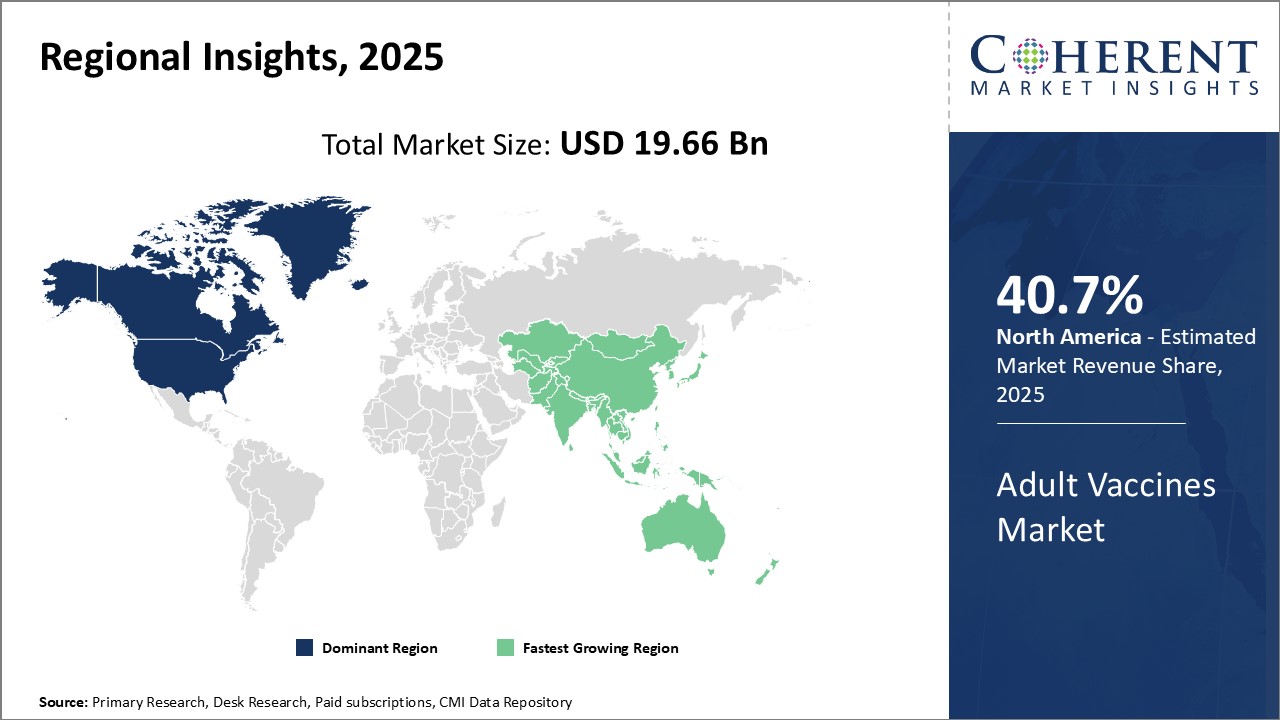Global adult vaccines market is estimated to be valued at USD 19.66 Bn in 2025 and is expected to reach USD 35.05 Bn by 2032, exhibiting a compound annual growth rate (CAGR) of 8.6% from 2025 to 2032.

Discover market dynamics shaping the industry: Download Free Sample
Growing prevalence of diseases like influenza, COVID-19, pneumococcal disease, and others across the globe can boost demand for adult vaccines. Factors like rising healthcare awareness, increasing focus on immunization programs by governments and non-profit organizations can also drive the market growth. Ongoing pipeline developments and new product launches can drive the market growth. Several pharmaceutical players are investing heavily in research and development activities to develop novel adult vaccines for diseases lacking vaccination. However, low awareness levels in developing nations and high costs associated with vaccine development can hamper the market growth.
Increasing prevalence of adult diseases
Increasing prevalence of adult diseases across the globe is can drive the global adult vaccines market growth. As people are living longer due to improved healthcare facilities and lifestyle changes, these people are more prone to develop age-related diseases. Unlike childhood diseases that can often be prevented through routine vaccination programs, adults require repeated booster doses of vaccines to stay protected against diseases like pneumonia, shingles, hepatitis, and influenza that risk increasing with age. Various reports from health organizations like the World Health Organization (WHO) and Centers for Disease Control and Prevention (CDC) show high incidence and mortality rates of adult vaccine-preventable diseases even in developed regions. For instance, according to the data published by CDC, influenza and its complications resulted in over 75,000 hospitalizations and over 5,000 deaths during the 2019-2020 in the U.S. According to the data published by WHO, Streptococcus pneumoniae remains one of the top ten causes of death in older adults and is responsible for an estimated 500,000 deaths yearly. Furthermore, as per data from United Nations, by 2030, one in six people in the world will be over 65 years. This demographic shift coupled with the increasing prevalence of non-communicable diseases puts adults at an elevated risk of not just infectious but chronic diseases as well. For instance, in September 2023, in 2022, according to the Centers for Disease Control and Prevention, 22 states in the U.S. have adult obesity rates at or above 35%, increase from 19 states in 2021. This trend underscores the pressing need for population-wide interventions, including access to healthy foods, safe environments for physical activity, and stigma-free obesity prevention and treatment programs. The data also reveal disparities across racial and ethnic groups, emphasizing the importance of targeted health equity initiatives. Addressing obesity is crucial for reducing the risk of chronic diseases and improving overall public health outcomes nationwide.

Get actionable strategies to beat competition: Download Free Sample
Lifestyle Changes
Changes in lifestyle and work-life balance can lead to increased risks of exposure to various communicable diseases among adults. More people are living in urban areas and traveling internationally for work or leisure on a regular basis. This has made the rapid global spread of infectious outbreaks much easier. At the same time, modern lifestyles with longer working hours and more hectic schedules leave less time for rest and self-care. Thus, even commonplace viruses like influenza can pose a serious health threat. Stressed immune systems make vaccination a sensible precaution. Activities like multiple sexual relationships increases the chances of contracting vaccine-preventable diseases like hepatitis. Growing awareness that maintaining strong immunity through vaccination plays an important supporting role to other preventive healthcare practices in allowing adults to lead active lifestyles with fewer illness-related disruptions.
Key Takeaways from Analyst:
Global adult vaccines market growth is driven by rising awareness among individuals regarding the necessity of vaccination. High prevalence of diseases such as influenza, hepatitis, and pneumonia prompts individuals to seek vaccination on priority. Manufacturers are also increasingly focusing on development of new adult vaccines targeting high risk population groups, and this can drive the market growth.
North America currently dominates the market due to presence of leading pharmaceutical players and favorable regulations. However, Asia Pacific is likely to emerge as the fastest growing market due to improved access to vaccines coupled with rising healthcare spending in countries like China and India. New product launches by regional and global industry players can boost the uptake of adult vaccination in Asia Pacific.
High development and production costs associated with adult vaccines can pose challenges for market players. Stringent regulations pertaining to clinical trials and product approval can also hamper the market growth. Lack of vaccine awareness among population in underdeveloped nations can restrain market expansion. However, growing partnerships between governments and international organizations to strengthen immunization programs can offer new opportunities in the future.
Market Challenge: High development cost of adult vaccines
The high development cost of adult vaccines can hamper the global adult vaccines market growth. Developing an efficient and safe vaccine requires extensive research and clinical trials over many years. This lengthy and rigorous research process increases development costs. Setting up large scale manufacturing facilities to produce millions of doses also involves substantial capital investments. With higher development costs, vaccine makers need to recover their investments through product sales over many years. However, adult population requiring routine immunization is significantly smaller as compared to pediatric populations. This limited patient volume makes it difficult for companies to achieve adequate sales volumes needed to offset the high development expenditures in a short time. Furthermore, developmental challenges and regulatory hurdles increases costs. Adults have more complex immune systems compared to children, requiring more research to develop vaccines that can effectively trigger immune response in adult bodies. Regulatory agencies also mandate extensive clinical testing through various phases to establish safety and efficacy in adult populations before approval. This lengthy regulatory process from research to market approval can take 10-15 years. The related costs accumulated over this long cycle put pressure on pricing, once the vaccine is launched. With reduced profit margins and uncertain returns, vaccine makers demonstrate lack of interest in investing heavily into the development of new adult vaccines.
Market Opportunities: New disease indications
The discovery of additional disease indications for existing adult vaccines can drive the market growth. As scientists gain deeper understanding of the human body and microbiome, these are able to uncover additional pathogens and diseases that existing vaccines may be effective against. For example, recent studies have indicated certain strains of human papillomavirus (HPV), the target of HPV vaccines, may also play a role in developing some head and neck cancers. If clinical trials can prove HPV vaccines lower risks of these cancers as well, it would represent a major new indication that could widen the eligible population for vaccination worldwide. Similarly, research is ongoing into whether pneumococcal and herpes zoster vaccines approved for older adults may also offer cross-protection against diseases like influenza or even coronary heart disease. Finding evidence to support new preventative indications would considerably increase the public health impact and uptake of these vaccines. Future trends in disease progression and epidemiology also create opportunities. As global populations age in many countries and non-communicable diseases rise, there will be growing demand for vaccines that protect against diseases such as pneumonia and shingles that disproportionately threaten older adults. Furthermore, changes in disease patterns mean certain populations now face higher risk profiles than in the past. Global rise of obesity and associated health conditions can lead to diabetes epidemic. This increases vulnerability to other diseases, raising the need for prevention options such as an effective influenza vaccine for adults with diabetes.

Discover high revenue pocket segments and roadmap to it: Download Free Sample
By Vaccine Type - Higher awareness about disease prevention and multidisease protection drives the multivalent vaccines segment
In terms of vaccine type, multivalent segment is estimated to contribute the highest market share of 60.6% in 2025. Multivalent vaccines provide protection against multiple diseases by using a single shot, thus, offering added convenience over monovalent vaccines which target a single disease. These help healthcare providers optimize vaccination schedules and reduce the number of required injections. This higher adherence to vaccination programs translates to better overall prevention and community protection. Individuals are increasingly recognizing that vaccinations provide multi-disease protection and help build a robust immune defense against various serious infections. This has boosted demand for multivalent adult vaccines that offer cost-effective prevention against multiple diseases with a single dose administration. The convenience and awareness around disease avoidance through multivalent vaccines can boost its demand as compared to monovalent options.
By Vaccines - Rising geriatric population and higher risk of contracting influenza drive the influenza vaccines segment
In terms of vaccines, influenza segment is estimated to contribute the highest market share of 25.6% in 2025 as large population are at high risk of contracting influenza. The elderly population above 65 years of age and individuals with chronic illnesses are at significantly higher risk of influenza-associated complications. As the average life expectancy rises globally due to advancements in healthcare, there is increase in geriatric population. According to United Nations Data, the number of people aged 65 years and above is projected to reach over 1.5 billion by 2050 from 703 million in 2019. This growing senior population base is a major consumer of influenza vaccines as their immunity weakens with age. Furthermore, influenza, commonly known as flu, poses severe health risks such as pneumonia or even death for people with chronic conditions like lung disease, heart disease, diabetes, among others. Thus, influenza vaccination is considered an important measure for prevention among high-risk groups. The need to curb influenza complications and healthcare costs associated with the rapidly expanding aging demographics and prevalence of chronic diseases can boost demand for influenza vaccines.
By Technology - Advancements in viral production technologies boost the inactivated viral/bacterial vaccines segment
In terms of technology, inactivated viral/bacterial vaccines segment is estimated to contribute the highest market share of 20.6% in 2025 due to continuous improvements in viral production technologies that allow for higher, more consistent yields of inactivated vaccines. Compared to other technologies like live attenuated and subunit vaccines, inactivated vaccines using traditional methods exhibit lower immunogenicity as the virus is destroyed during manufacturing. However, optimized cell culture and purification techniques have increased viral titers, resulting in more immunogenic inactivated vaccine products. This has enhanced their safety profiles and ability to induce longer lasting immunity similar to live vaccines. Furthermore, new adjuvant systems that boost the immune response to inactivated viral antigens have widened their applicability. With advancements addressing previous limitations, inactivated vaccines now offer stable protection against various infectious threats like influenza and hepatitis. . Rising efficacy and safety of inactivated viral vaccines owing to technological upgrades in production can drive the segment growth.

Need a Different Region or Segment? Download Free Sample
North America dominates the global adult vaccines market with an estimated market share of 40.7% in 2025. The presence of major vaccine manufacturers and favorable government policies can drive the market growth. The U.S. accounts for the major share due to initiatives by CDC and FDA to promote immunization programs. Established healthcare infrastructure and high awareness among individuals for preventive healthcare boosts vaccine adoption.
The Asia Pacific region has emerged as the fastest growing market for adult vaccines globally. Countries like India, China and Japan are high potential markets due to their huge population bases and improving healthcare landscapes. Rising income levels have also increased affordability of vaccines in the region. Various initiatives by governments to increase immunization rates can also drive the market growth. For instance, the Indian government aims to eliminate vaccine-preventable diseases through universal immunization under 'Mission Indradhanush'.
Among exporters, North American countries such as the U.S. contribute significantly to global supplies due to their export focused major manufacturers. However, regional players from India and China have increased their exports footprint in recent times leveraging their large production capacities and competitive pricing of vaccines. Countries in Asia Pacific and Latin America primarily import adult vaccines to meet the demand-supply gap due to limited indigenous manufacturing capabilities. Cross-border trade of adult vaccines is driven majorly by tenders from United Nations agency procurement as well as regional governments and private organizations.
Adult Vaccines Market Report Coverage
| Report Coverage | Details | ||
|---|---|---|---|
| Base Year: | 2024 | Market Size in 2025: | USD 19.66 Bn |
| Historical Data for: | 2020 To 2024 | Forecast Period: | 2025 To 2032 |
| Forecast Period 2025 to 2032 CAGR: | 8.6% | 2032 Value Projection: | USD 35.05 Bn |
| Geographies covered: |
|
||
| Segments covered: |
|
||
| Companies covered: |
GlaxoSmithKline plc, Merck & Co., Inc., Pfizer Inc., Sanofi Pasteur, AstraZeneca, Johnson & Johnson, Novavax, Inc., Moderna, Inc., Inovio Pharmaceuticals, Inc., Bavarian Nordic, Dynavax Technologies Corporation, BioNTech S, Emergent BioSolutions Inc., Serum Institute of India Pvt. Ltd., Bharat Biotech, Sinovac Biotech Ltd. |
||
| Growth Drivers: |
|
||
| Restraints & Challenges: |
|
||
Uncover macros and micros vetted on 75+ parameters: Get instant access to report
*Definition: Global Adult Vaccines Market involves vaccines that are administered to individuals aged 19 years and older. These vaccines help protect adults against tetanus, diphtheria, pertussis, seasonal influenza, pneumococcal disease, human papillomavirus and herpes zoster. The global adult vaccines market includes revenues from vaccines targeting diseases such as influenza, cervical cancer, hepatitis, pneumonia and herpes zoster. Key players in this market are developing new and improved vaccines to widen immunization coverage among adult populations worldwide.
Share
Share
About Author
Ghanshyam Shrivastava - With over 20 years of experience in the management consulting and research, Ghanshyam Shrivastava serves as a Principal Consultant, bringing extensive expertise in biologics and biosimilars. His primary expertise lies in areas such as market entry and expansion strategy, competitive intelligence, and strategic transformation across diversified portfolio of various drugs used for different therapeutic category and APIs. He excels at identifying key challenges faced by clients and providing robust solutions to enhance their strategic decision-making capabilities. His comprehensive understanding of the market ensures valuable contributions to research reports and business decisions.
Ghanshyam is a sought-after speaker at industry conferences and contributes to various publications on pharma industry.
Missing comfort of reading report in your local language? Find your preferred language :
Transform your Strategy with Exclusive Trending Reports :
Frequently Asked Questions
Joining thousands of companies around the world committed to making the Excellent Business Solutions.
View All Our Clients